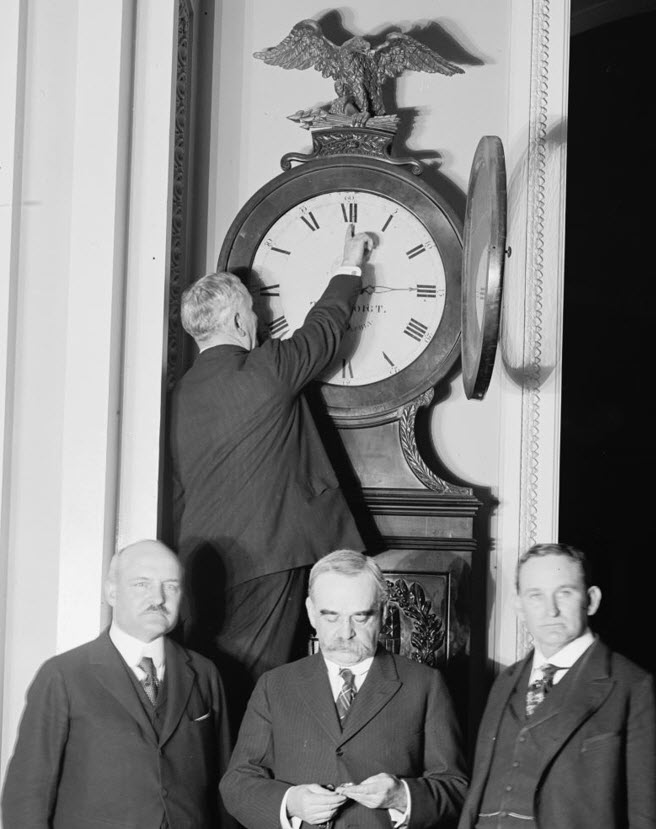By TR Robertson
It will soon be here again, the night you will have to remember to turn your clocks ahead one hour, best remembered by the adage “Spring Ahead, Fall Back”, otherwise known as Daylight-Saving Time. This year the date and time you will have to remember is early Sunday morning, March 10, 2024, 2 am, although most people will set their clocks back Saturday night before they go to bed. Your cell phones, computers, cable boxes, newer cars will change automatically. But anyone without items of modern technology will have to reset watches, clocks in homes, clocks in older cars and anywhere a clock can be found. This time change occurs twice a year in all but two of the states in the United States, Hawaii and Arizona do not observe Daylight-Saving Time (except for the Navaho Nation in Arizona).
Most people know about this yearly occurrence, but few know the story behind why we have Daylight-Saving Time and the arguments for and against keeping this event twice a year. The basic premise is we advance clocks one hour during the warmer months, so darkness falls at a later clock time, and we set clocks back one hour in the fall to return to standard time. Ancient civilizations, like the Romans, adjusted their daily schedules centering around the sun often dividing the clock times into 12 hours regardless of the time of day. This allowed them to adjust the daylight hours as the amount of sunlight became progressively longer. During the spring and autumn hours daily work and agricultural schedules could then be adjusted to the amount of sunlight needed to complete their work.
In the 1700’s, Benjamin Franklin published a series of proverbs, one being “Early to bed and early to rise, makes a man healthy, wealthy and wise.” While in France he wrote an article suggesting the Parisians economize on the number of candles they used by rising earlier to use morning sunlight to begin their workday.
Port Arthur, Ontario, Canada was the first city in the world to enact Daylight-Saving Time, beginning on July 1, 1908. The German Empire and their World War I ally Austria-Hungary adopted Daylight-Saving Time on April 30, 1916. Britain and their allies soon followed. The United States would adopt DST in 1918. DST became common during World War II and was widely adopted in America and Europe during the 1970’s, because of the energy crisis.
There was a myth that Daylight-Saving Time was implemented for the benefit of farmers. The truth is most farmers oppose DST. Farmers’ schedules are dictated by the sun, one example being dairy cattle and their readiness to be milked when the sun is up. Most farmers are up prior to sunrise for a long day of work in the sun, regardless of the time.
Daylight-Saving Time was implemented in the United States with the Standard Time Act of 1918, setting a period of 7 months of additional daylight time to conserve energy resources. This Act designated five time zones for the United States. In 1966 the Uniform Time Act promoted the adoption and observance of uniform time within the Standard Time Zones. Permanent Daylight-Saving Time was enacted in 1974, but complaints arose about children going to school in the dark and workers starting their workday in pitch darkness during the winter months. The Permanent Daylight-Saving Time was repealed in 1975. Starting in 2007 the United States and Canada observed Daylight Saving Time from the 2nd Sunday in March to the 1st Sunday in November.
There has been an argument and controversy about Daylight-Saving Time since its inception. Retailers, sports teams, and tourism companies have favored DST but agriculture, evening entertainment and some religious groups have not been in favor of DST. Proponents argue that DST saves energy and promotes outdoor activity, saying it also reduces traffic accidents and crime. Opponents say the energy saving statistics are inconclusive and they say it disrupts the human circadian rhythms negatively affecting human health. There has been various movements and discussions to stay on a permanent DST, staying on the summer hours all year, most health experts advocating for this movement. To do this would take an act of Congress to change the current Federal law. Most surveys taken involving the public have mixed reactions with no clear majority to change the law.
Two states do not use Daylight-Saving Time, Hawaii and Arizona. The Navajo Nation in northeastern Arizona does comply with DST so it has uniform time with the Navajo territory in Utah and New Mexico. The Commonwealth of Puerto Rico, Northern Mariana Islands, U.S. Virgin Island, American Samoa, and Guam also do not observe DST.
Regardless of your feelings about Daylight-Saving Time, be prepared on Sunday, March 10, 2024, at 2 am, to see your clocks “Spring Ahead”, and your morning and evening sunrise and sunsets will begin to look a lot different. The next time change will occur on Sunday, November 3, 2024.



















